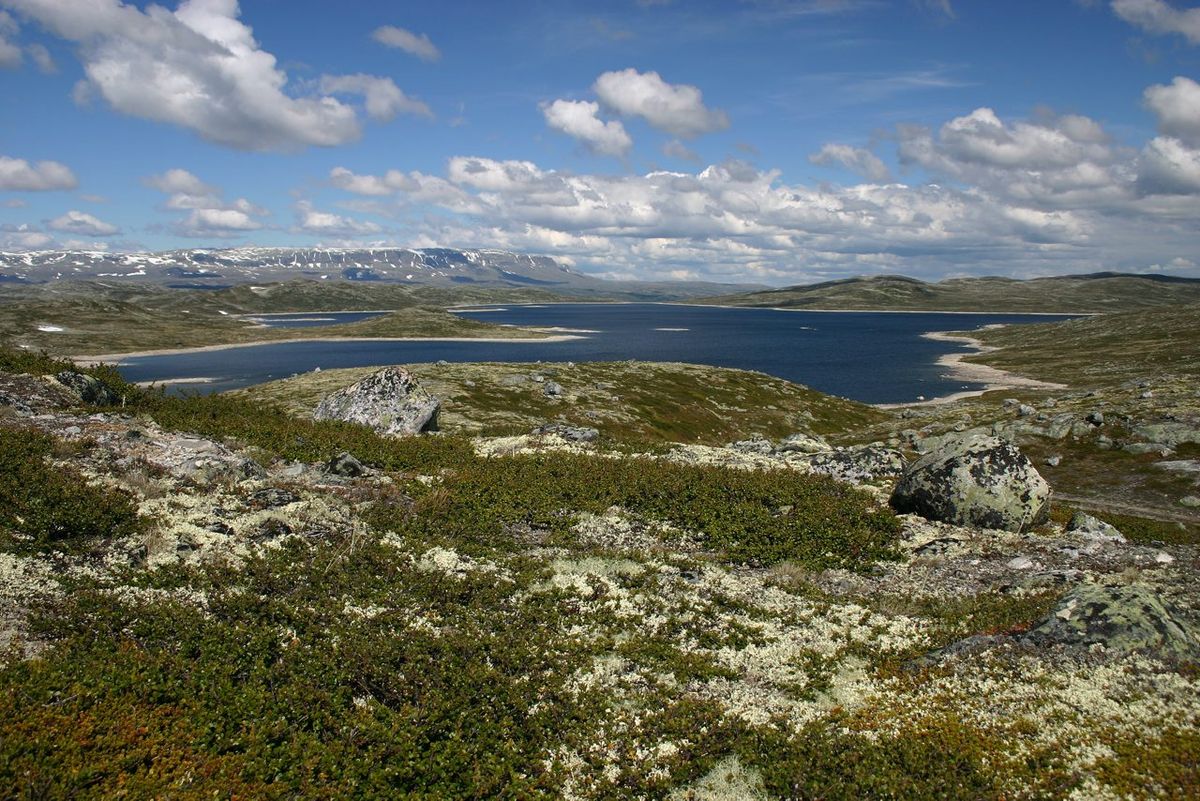By Smtunli, Svein-Magne Tunli
Growing up in Norway, I spent many of my summers up at the family cabin at Haugastøl, close to the Hardangervidda. The cabin is located at 900 meters above sea level, only 100 meters lower than the lowest regions of the plateau. It has been in the family since the 1920s.
Back in 1920, the tree line was well below 900 meters. The property was mainly rocks covered by moss, with the odd bush here and there. So rare were the bushes that my grandmother's aunt, the original owner, left strict instructions not to cut any of them when she handed it over to my grandmother.
Little did they know back in the 1950s, that the whole area would see a rapid transformation from open, barren land, to thick vegetation. The bushes that they had fretted about invaded the property, making it almost impossible to get around. Where my grandmother's aunt was able to walk about, my grandmother was suddenly restricted to narrow paths through the rapidly expanding foliage.
Trees started invading the property too. Suddenly there were tiny birch trees everywhere.
Organic matter started clogging the natural drainage surrounding the cabin. The little bog down towards the lake expanded. Mosquitoes were suddenly everywhere.
Something had to be done. In the space of 20 years, the cabin's surroundings had gone from a dry and largely barren highland to be a wet and mosquito infested wilderness.
My grandmother started cutting down the bushes around the cabin. Left untamed, the wilderness would otherwise completely consume the cabin.
Ever since then, cutting down unwanted foliage has been a regular summer activity at the cabin. The wilderness has been pushed back. Bushes have been removed, and trees have been trimmed or cut down completely.
Every summer, I use a scythe to level the foliage around the cabin. Where there was only barren rocks and a bit of moss some 70 years ago, there is now a meadow, with medium sized birch trees, neatly trimmed so that anyone can walk under them without having to bend their heads.
The most dramatic part of this transformation happened during my lifetime. I have seen this happen with my own eyes, and it never ceases to amaze me how quickly nature can change. In geological terms, this all happened in the blink of an eye.
The tree line, which has moved from a little below 900 meter to a little below 1000, has now reached Hardangervidda, and the changes that took place around the family cabin are now about to happen for vast areas all over the plateau.
Rocks are already covered with moss and flowering plants. Bogs are clogging up, and bushes and birch trees are starting to appear. At the current rate, large parts of Hardangervidda will be covered by forest within the next 100 years.
Large parts of Hardangervidda were covered in forest during the Medieval Warm Period, and it looks like we are set for a repeat.
The Little Ice Age gave its final gasp back in the early 1900s, roughly corresponding to the time when vegetation started to make its big comeback in higher-lying areas of Norway.
Going farther back in time to the early and mid Holocene, some 10000 years ago, we know that there were no glaciers in Norway and that all of Norway was covered in forest.
However, the trend has since been that of re-glaciation, with glaciers expanding and retreating through periods of relative cold and relative warmth, but growing on average.
The Medieval Warm Period lasted from about 950 to 1250, while the Little Ice Age lasted from about 1300 to 1900. The warm period lasted 300 years while the cold period lasted 600 years.
At present, we are 100 years into the Modern Warm Period. If it lasts as long as the previous warm period, we still have 200 years to go. However, there are reasons to believe that we may already have peaked.
We are at present entering a Grand Solar Minimum. The previous Grand Solar Minimum occurred during the Little Ice Age.
The only difference between the climate conditions during the onset of the Little Ice Age and now is that we now have 0.04% CO2 in the atmosphere, while the amount was below 0.03% back then.
Some believe that this difference in CO2 content in Earth's atmosphere will be sufficient to counter the negative effect of the Grand Solar Minimum. However, it remains to be seen if this is the case.
A good place to watch for evidence as to which way we are heading is no doubt Hardangervidda. If we see a forest springing up on the plateau over the next few decades, we are most likely heading towards continued good weather. On the other hand, if the snow patches and glaciers that litter the plateau start growing and persist for longer than they have of late, we are most likely returning to the cold conditions that have dominated the last 1000 years.
When I last visited Hardangervidda in August of 2016, there were plenty of snow patches still laying around, and there was a chill in the air. We even had some snow flurries coming down at us from the low hanging clouds that drifted in from the Hardangerjøkulen glacier to the north.
If the last few years is any guide to where we are heading, I'd say that Hardangevidda will not be forested again, and that we will slip into another Little Ice Age. Hopefully, time will prove me wrong.

No comments:
Post a Comment